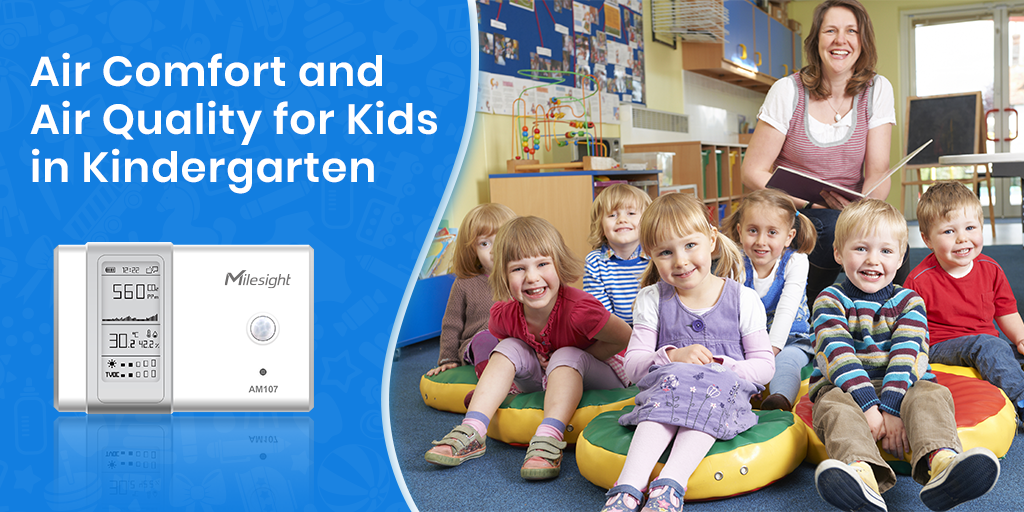Poor air quality is a subtle threat to health but has been shown to harm the health and development of adults, not to mention children. According to WHO, an estimated 4.2 million premature deaths are associated with air pollution. Children are sensitive to air pollution and face special risks since their lungs and immune systems are growing and they have more respiratory infections, thus poor indoor air quality monitoring is the main challenge kindergarten faced.
However, unlike other air pollutants such as nitrogen oxides, sulfur dioxide and particulate matter, the main pollutants kindergarten faced are CO2 (carbon dioxide) and VOCs (volatile organic compounds). Besides the air pollution, an uncomfortable air environment also has a negative impact on mood, concentration and staff/children's performance which should be taken into consideration.
In this way, indoor air quality monitoring in kindergarten is the fundamental step to create comfort and foster well-being for children and staff.

Related Factors
CO2 (carbon dioxide) In kindergarten, CO2 mainly comes from normal cell function and is removed from the human body. Poor ventilation will generate high levels of CO2, which can produce a variety of health effects. High level of CO2 may cause fatigue, poor concentration and dizziness. According to ASHRAE, the CO2 concentration level should be less than 1000 ppm. TVOC (total volatile organic compounds) The term TVOC refers to the total concentration of multiple airborne VOCs. Children with higher VOC concentrations may also be more likely to develop asthma, allergic rhinitis and eczema than children who have had less VOC exposure. Temperature and Humidity Temperature is the most obvious factor of comfort. Both the hot and cold temperature would lead to discomfort. The relative humidity is the amount of water vapor present in the air. Children in the low level of relative humidity will complain of dry eye and flaky skin, and have increased risk of respiratory illnesses. ASHRAE Standards specify ideal comfort ranges of 20 to 23.5 ℃ at 40% to 60% relative humidity in the winter months and 23 to 25.5 ℃ at 40% to 60% relative humidity in the summer months. Featured Product
 Milesight AM107 can monitor temperature, humidity, CO2, TVOC, barometric pressure, light and motion with an E-ink screen to show environmental data. It also has a clean and modern design that makes it discrete in indoor ambiance.
In this scenario, LoRaWAN®, a long-range and low-power wide-area network technology, is ideal for transfer sensing data. By leveraging LoRaWAN®, one Milesight LoRaWAN® gateway can cover the whole kindergarten and connects to hundreds of AM107 sensors. Also, the low power consumption feature of LoRaWAN® makes it possible for AM107 to work 1 year only with 2 alkaline AA batteries.
Kindergarten managers can remotely monitor the air quality of each classroom on Milesight Cloud and quickly respond to bad air quality such as adjusting the HAVC system.
Milesight AM107 can monitor temperature, humidity, CO2, TVOC, barometric pressure, light and motion with an E-ink screen to show environmental data. It also has a clean and modern design that makes it discrete in indoor ambiance.
In this scenario, LoRaWAN®, a long-range and low-power wide-area network technology, is ideal for transfer sensing data. By leveraging LoRaWAN®, one Milesight LoRaWAN® gateway can cover the whole kindergarten and connects to hundreds of AM107 sensors. Also, the low power consumption feature of LoRaWAN® makes it possible for AM107 to work 1 year only with 2 alkaline AA batteries.
Kindergarten managers can remotely monitor the air quality of each classroom on Milesight Cloud and quickly respond to bad air quality such as adjusting the HAVC system.
Benefits
All in oneMilesight AM107 can monitor temperature, humidity, CO2, TVOC, barometric pressure, light and motion. It’s ideal not only for indoor air quality monitoring but also for many applications such as room occupancy monitoring and lighting management
7*24 remote monitoringKindergarten managers can remotely monitor the air quality of each classroom to take quick action to maintain a comfort and healthy environment.
Easy to use and installBased on the special design, it’s easy to apply the whole solution within half a day. Easier installation, easier connection and easier monitoring.











